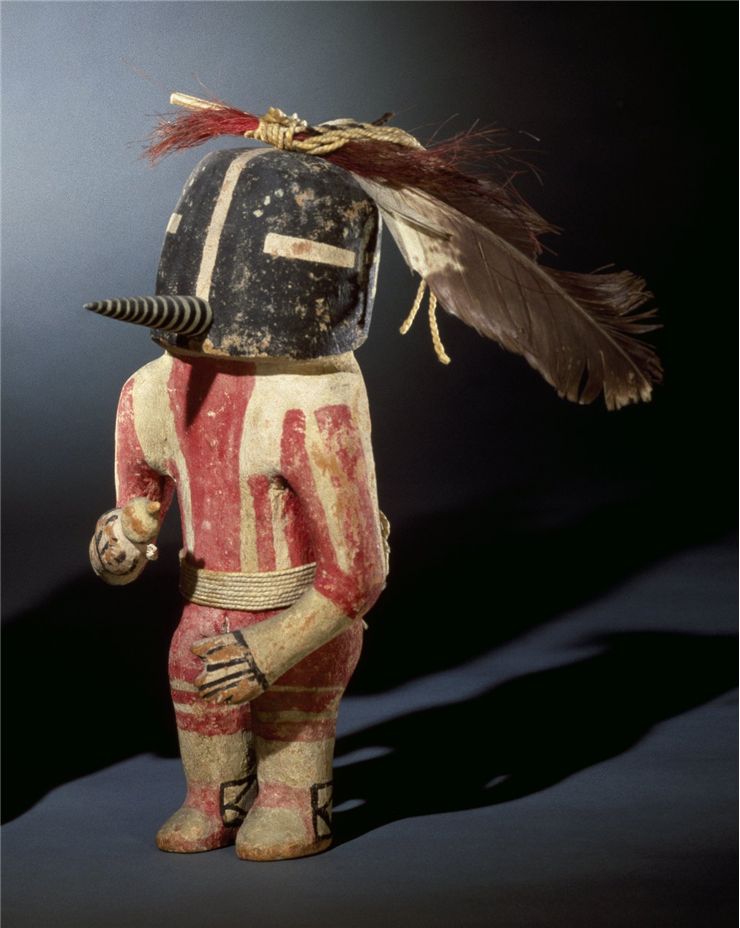Kachina - Spirits, Meanings and Types of Kachina Dolls
Kachina dolls are figures made by Native American, mainly western Pueblo (including Hopi, Zuni, Tewa Village, Acoma Pueblo and Laguna Pueblo). They are made from cottonwood root as a teaching tool to represent children not only men kind but spiritual and natural elements of life in Hopi religion. In order to show whole life and religious beliefs, there are different types of dolls, some represent people (clowns, singers, Warriors), some animals (eagles, buffalos, butterflies), some natural forces (thunderstorms, the wind) and some planets and stars (the sun, the moon, earth).
Kachinas aren't just dolls, but - as a major element of Hopi religion - spirit essence of everything around people. It is believed that they have power over nature, so they were treated as intermediaries between the physical and the spirit world, like a tool to control the whole natural world. During tribal festivals, villagers masked themselves to act Kachinas.
Southwest Native Indian tribes had Kachina spirit for every purpose (they called them wuya), so it's not surprising that today we count around 900 Kachinas. When Kachina ceremony was occurring in village plaza, each masked Indian dancer presented a type of Kachina. This imitative animal dance was usually interrupted by clown’s performances. Even though Indians carved these dolls for children of the tribes (and for women, because to them it wasn't allowed to act Kachinas in collective dance) as a gift during their festivals, some Kachina dolls were made just for religious ceremonies.
The first Kachina doll was collected from Hopi and represented to National Museum in 1857 by Dr. Palmer, a U.S. Army surgeon, but it is believed that Kachinas were noticed long time before that. For example, in the 16th century, Spanish sailors wrote about "strange images of the devil" hanging in Hopi homes - they must have meant on Kachina figures, which were decorated with nature elements like bird feathers and fur.
In the Hopi language, the word "Kachina,"(these dolls are also known as Katchina, Katcina, Katsina or Qatsina) means "life Bringer". Traditional Kachina doll is more figure than a doll: this simplified form is usually painted with natural pigment, decorated with sticks and leaves and sometimes even with human hair.
In history, Kachinas are considered some sort of guardians or even messengers to the Gods (Hopi religion had 400 mythical beings), so it wasn't allowed to children to play with them. Dolls were used just for religious education. Every child had their doll (or better said, religious object) and had to decorate home with it, so he could memorize how Kachinas look like. There were four types of dolls depending how old the child is:
- Putsqatihu - for infants (it was simple flat figure)
- Putstihu taywa’yla - for toddlers (doll was made with flat body, but 3-dimensional face)
- Muringputihu - for infant girls (doll had carved face and cylinder body)
- Tithu (what most people think of as Kachina dolls) - for children ages 2 and up (figure was fully developed, so most resembles a doll)
Even today it is very hard to classify Kachinas due to many ideas about one's function. However, they are separated into four stylistic periods: The Early Traditional, Late Traditional, Early Action, and Late Action periods.
There are different sizes of Kachina dolls - from a few inches to over 20 inches in height. Used colors are always important because of its symbolism - yellow means north, red south, while the black represents the underworld.
On the modern Kachinas, there are more realistic details, and they are all alike in clothing. They are not made from just one piece of wood or root like earlier, but with hear and limbs separately. Today there is an even female form of former male dolls, and there is also the miniature Kachina figure, which is not real Kachina but more souvenir for trade.
The most important dolls are Tawa Kachina (symbol of sun, also of life and growth), Hemis Kachina (rain Kachina which was used to beckon the rain) and Masau Kachina (ruler of underworld, but also controller of the world), but the most popular dolls are the Tasapkachina (Navajo Kachina, doll with feathered headdress), Angakchina (figure with long flowing hair that represents the rain falling) and animals like Bear Kachina Doll.
